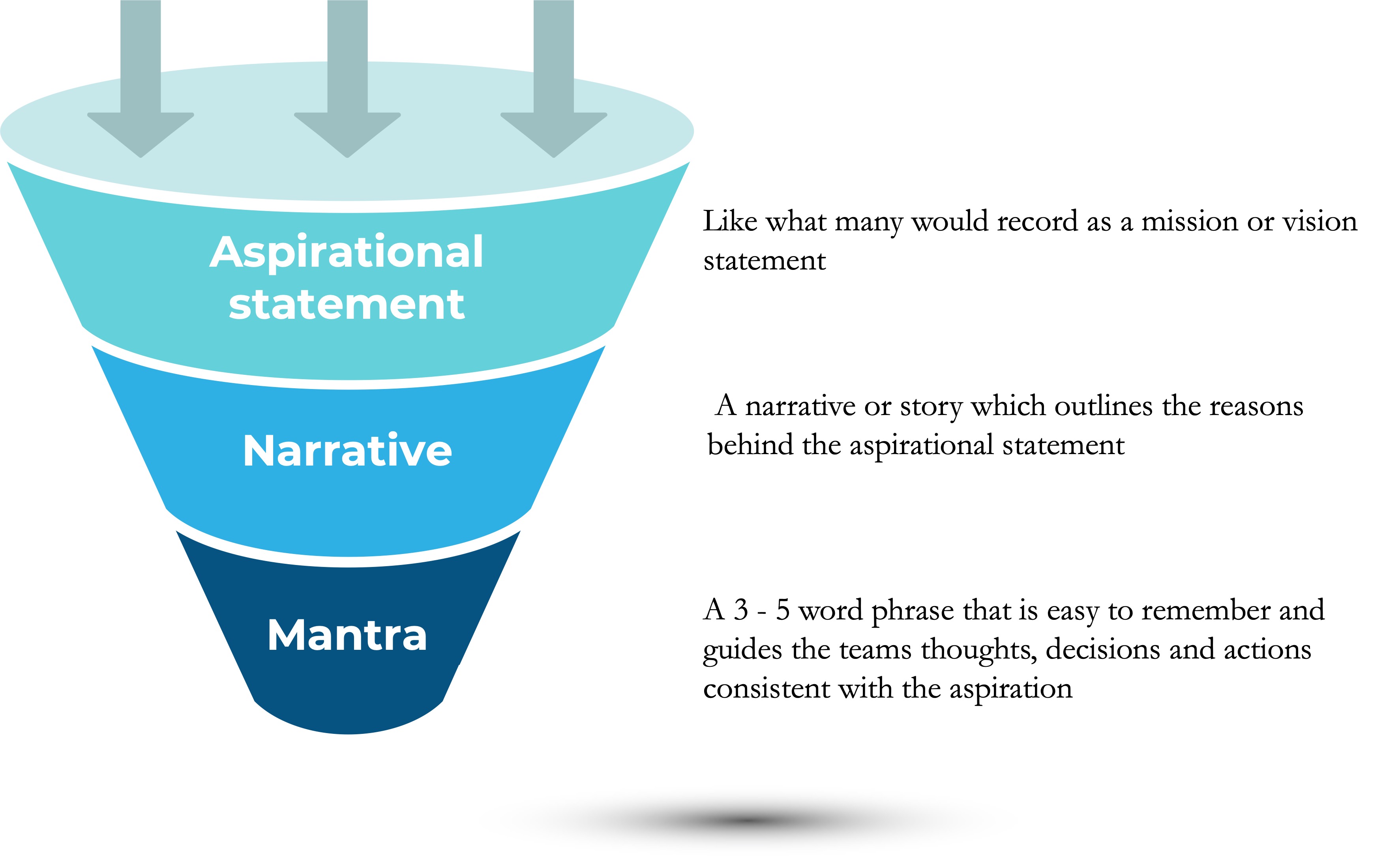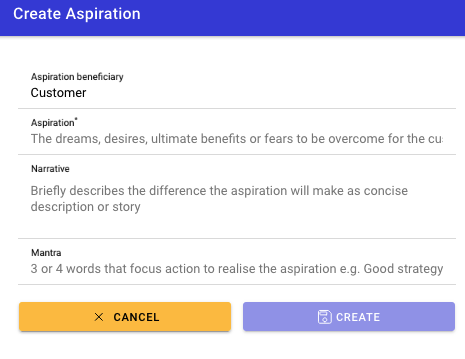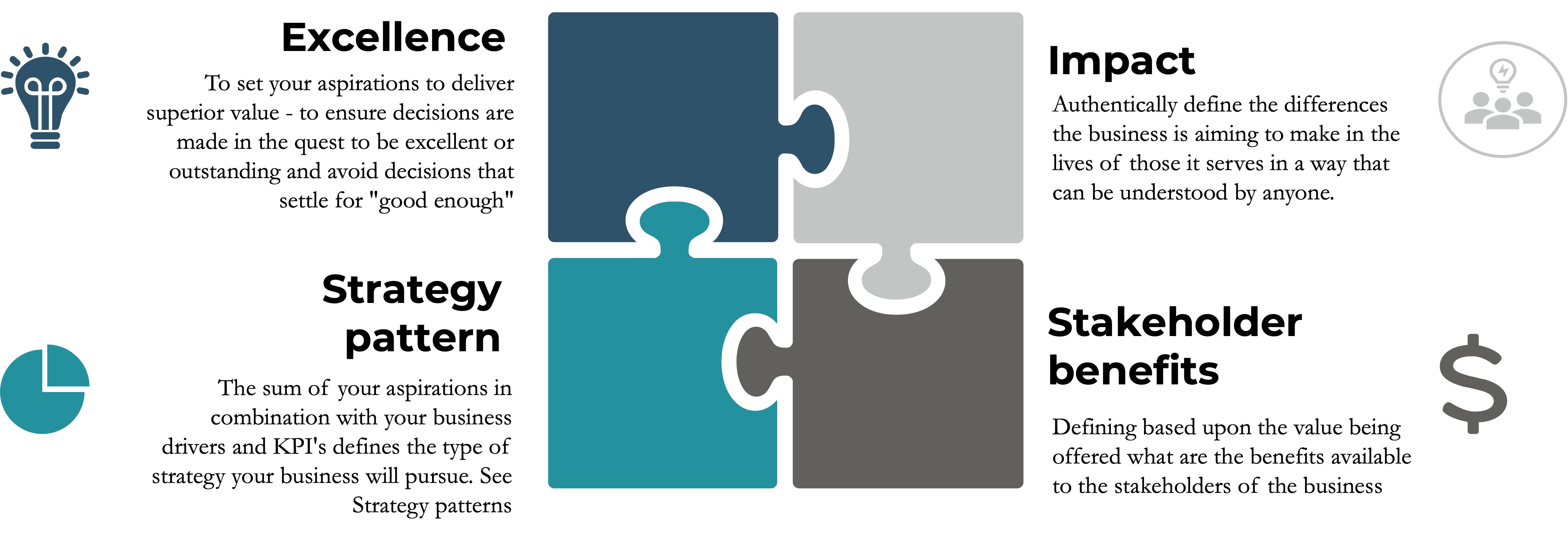-
Overview
-
Your Aspirations in StrategyCAD
Aspirational structure and logic
-
Your Customer Aspirations
Includes example
-
Your Business Aspirations
Includes example
Introduction
Aspirations define the purpose of your business or a line of business. Aspirations define what success looks like for both for the contributions the business makes to the community it serves and how the value captured by the business provides benefits back to the stakeholders of and in the business.
Aspirations as the foundation of excellence
Lafely and Martin in their Playing to Win Book compel business leaders
to define a winning aspiration – in terms of providing superior customer value
in their chosen market. They state that anything less than a winning aspiration
creates an environment of mediocrity and if a team are not aiming to deliver
superior value, then they will not make the decisions necessary to win.
To win, the business must find a way to delight customers in way(s) that others cannot.
This can be providing a quality product at a price unmatched or a product the solves
customers problems with a level of delight that is unavailable anywhere else.
In the absence ambitious aspiration
a business is just another face in the crowd, and subject
to the threats of buyer power, new entrants and substitutes. (Later in this guide)
StrategyCAD Aspiration structure
Aspirations in StrategyCAD are partitioned into two
- Customer aspirations
- Business aspirations
Each of these includes 3 elements
- Aspirational statement - likely equivalent of the mission or vision statement
- Narrative - a narrative or story which outlines the reasons behind the aspirational statement
- Mantra - a 3 - 5 word phrase that is easy to remember and guides the teams thoughts, decisions and actions consistent with the aspiration.

The role of the aspirational statement
This is the equivalent of the mission or vision statement. It is a one or two sentence statement that outline the highest level aspiration or goal of the business. Everything the business does should be relevant to this goal and nothing it does should compromise it.
The role of the narrative
Human beings communicate through the grapevine and through generations by telling stories. Human beings almost never communicate in mission and vision statements. Your narrative acts as a relatable story that supports and provides the "WHY" behind the aspirational statement and enables your aspiration to be connected with and recalled by your audience.
The mantra
Guy Kawasaki in his 10 significant points of Innovation suggests you start with determining how you can create meaning or make a positive impact on those you choose to serve. In the presence of this aspiration, he suggests your business will change the world for the better for some people. When your business changes the world, then you will also make money, he states. He then suggests a mantra, a 3-5 word phrase that is easily recalled that provides the recall of what impact the business is to make to guide decisions and actions. Simon Sinek, proposes to attract great people who will dedicate their time, talent and energies - the business needs a just cause, this is captured in your aspirations and quickly shared in your mantra.
Define your customer aspiration
Aspirations speak to your customers dreams, hopes and fears.
Your business’s customer aspiration defines the impact you want your
business to have on those it chooses to serve.
What meaning will your business create in the life of those it serves?
NOTE: your customers needs to include those who directly consume your
products and services and ideally everyone who consumes
your product or service. If you are developing a strategy for
an internal department your direct consumers may not
be the same end customers served by the business.
If you have intermediaries between your business and your customers,
it is beneficial to consider your aspirations for those intermediaries.
These intermediaries are also customers as they consume the outputs of your business.
Your customer aspiration defines:
A statement of the dreams, hopes and fears do you want to resolve for your customers?
A narrative the describes this resolution as a short story? Humans have always told stories Stories are a vital part of communication, and creating connection. that we can relate to.
A mantra 3 or 4 words as the simplified action statement?

Create aspiration dialog from StrategyCAD™
A simple example - IKEA the furniture retailer
Aspiration
Enable people all over the world
to create a beautiful home environment at an affordable price
Narrative
Cheap furniture can look cheap, bland and uninteresting.
We endeavor to enable people all over the world to furnish and fit out their homes
with affordable furniture and fittings, that delight them. When our
customers' walk into a home with their IKEA furniture
they feel pleased, delighted or proud. In fact, the whole customer
experience at IKEA is one of delight from browsing our catalogue,
parking at the store, to sitting
on an IKEA sofa, sleeping on an IKEA bed or cutting into a hot roast potato with
IKEA silverware.
Mantra
Affordable home furnishing that delights
NOTE: this is a mock example, not actually taken from IKEA.
Customer aspirations in StrategyCAD™
In StrategyCAD™ members of the Business can define one, two, twenty or more customer aspirations. You could allow leaders, team members and departments to add their own customer aspirations. As such it allows many or everyone in the business to express their own customer aspiration, in ways that are personally meaningful to them, rather than insist upon a single mission or vision statement.

A StrategyCAD™ aspiration "wall", contains two different business team members' perspective of their customer aspirations. Of course ideally, these should share commonality.
Define your business aspiration
Your business aspiration defines the impact you want your business to have for those who invest their capital, time, energy, and talents into it. Importantly, your business aspiration ideally identifies the type of strategy your business intends upon using to gain its advantage.
The business aspirations acknowledges that the business is in a symbiotic relationship with the community it serves. A complete aspiration recognizes the combination of providing superior value to those the business serves and capturing that value to assure the security of those who contribute to the business. The business aspiration represents capturing that value to assure the security of those who depend upon the success of the business.
Different business aspirations for different stakeholders
Investor stakeholders might primarily be interested in the return on their investment, and the reputation of the business.
Employee stakeholders might primarily be interested in career growth, the social good or an environment they love to work in.
Different stakeholders may have different business aspirations. Using the same Aspiration, Narrative, Mantra (optional) format you did for the customer aspiration. You can create one of more business aspirations.
Business mantra
A commonly occurring difference between the business and customer mantra is this.
The customer mantra is a what
the business or unique value proposition does for the customer.
Alternatively, the business aspiration is more about
How the team
anticipate succeeding. Some examples, We succeed together,
Build quality in, Strive for excellence, and Embrace the challenge.
Aspirations - your most important outcomes
The most important outcomes from defining your aspirations are:

The power of two
With both business and customer aspirations, your business, has a balanced external and stakeholder focus on what its' difference or contribution is going to be along with narrative about why and a ready recalled and actionable mantra.
Next steps
Review information on the additional tabs to be familiar with the logistics of creating your aspirations.
Clarified how will you measure your aspirational progress? In the next section you can define your Key Performance Indicators which are the measures of the extent to which the customer and business aspirations are being achieved. After that you can define the business drivers – things you can do and measure to enable your Key Performance Indicators.











